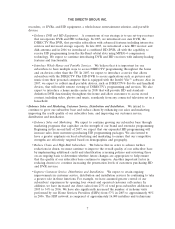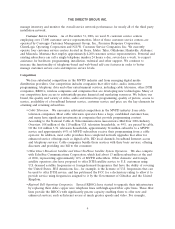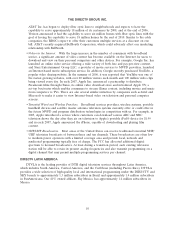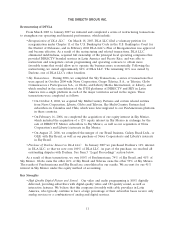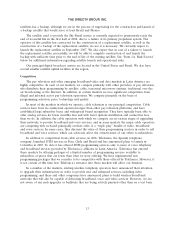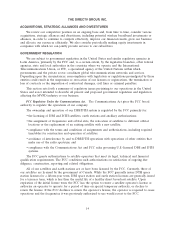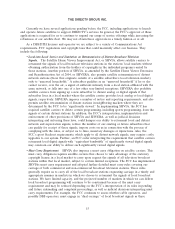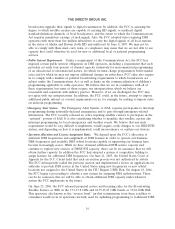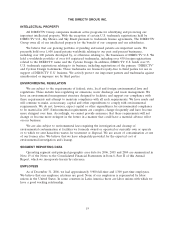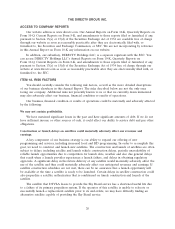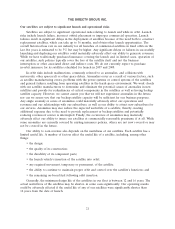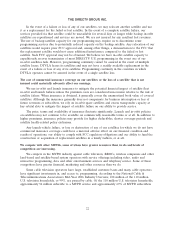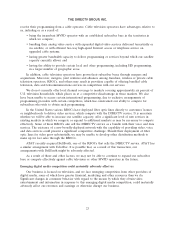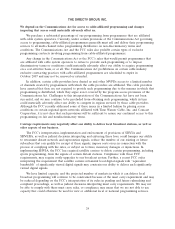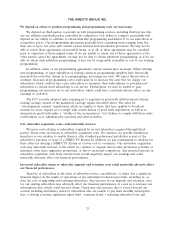DIRECTV 2006 Annual Report Download - page 27
Download and view the complete annual report
Please find page 27 of the 2006 DIRECTV annual report below. You can navigate through the pages in the report by either clicking on the pages listed below, or by using the keyword search tool below to find specific information within the annual report.THE DIRECTV GROUP, INC.
broadcasters upgrade their signals to digital transmission. In addition, the FCC is assessing the
degree to which satellite carriers are capable of carrying HD signals, or multicast digital
standard-definition channels, of local broadcasters, and the extent to which the Communications
Act requires mandatory carriage of such signals. Also, the FCC adopted rules requiring DBS
operators with more than five million subscribers to carry the digital signals of all local stations
in the states of Alaska and Hawaii (both HD and multicast) by June 8, 2007. We may not be
able to comply with these must carry rules, or compliance may mean that we are not able to use
capacity that could otherwise be used for new or additional local or national programming
services.
•Public Interest Requirement. Under a requirement of the Communications Act, the FCC has
imposed certain public interest obligations on DBS operators, including a requirement that such
providers set aside four percent of channel capacity exclusively for noncommercial programming
of an educational or informational nature, for which we must charge programmers below-market
rates and for which we may not impose additional charges on subscribers. FCC rules also require
us to comply with a number of political broadcasting requirements to which broadcasters are
subject under the Communications Act, as well as limits on the commercialization of children’s
programming applicable to cable operators. We believe that we are in compliance with all of
these requirements, but some of them require our interpretations, which we believe are
reasonable and consistent with industry practice. However, if we are challenged, the FCC may
not agree with our interpretations. In addition, the FCC could, in the future, attempt to impose
additional public interest or content requirements on us, for example, by seeking to impose rules
on indecent programming.
•Emergency Alert System. The Emergency Alert System, or EAS, requires participants to interrupt
programming during nationally-declared emergencies and to pass through emergency-related
information. The FCC recently released an order requiring satellite carriers to participate in the
‘‘national’’ portion of EAS. It is also considering whether to mandate that satellite carriers also
interrupt programming for local emergencies and weather events. We believe that any such
requirement would be very difficult to implement, would require costly changes to our DBS/DTH
system, and depending on how it is implemented, could inconvenience or confuse our viewers.
•Spectrum Allocation and License Assignment Rules. We depend upon the FCC’s allocation of
sufficient DBS frequencies and assignment of DBS licenses in order to operate our business.
DBS frequencies and available DBS orbital locations capable of supporting our business have
become increasingly scarce. While we have obtained additional DTH service capacity and
continue to explore new sources of DBS/DTH capacity, there can be no assurance that we will
obtain further capacity. In addition the FCC had adopted a system of competitive bidding to
assign licenses for additional DBS frequencies. On June 21, 2005, the United States Court of
Appeals for the D.C. Circuit held that such an auction process was not authorized by statute.
The FCC subsequently voided the previous auction and implemented a freeze on applications for
authority to provide DBS service in the United States using new frequencies or new orbital
locations not assigned to the United States in the ITU Region 2 BSS Plan. On August 18, 2006,
the FCC began a proceeding to identify a new system for assigning DBS authorizations. There
can be no assurance that we will be able to obtain additional DBS capacity under whatever
system the FCC implements in the future.
On June 23, 2006, the FCC released proposed service and licensing rules for the Broadcasting
Satellite Service, or BSS, in the 17.3-17.8 GHz and 24.75-25.25 GHz bands, or 17/24 GHz BSS.
This spectrum, also known as the ‘‘reverse band’’ (in that transmissions from these satellites to
consumers would occur in spectrum currently used for uplinking programming to traditional DBS
16



